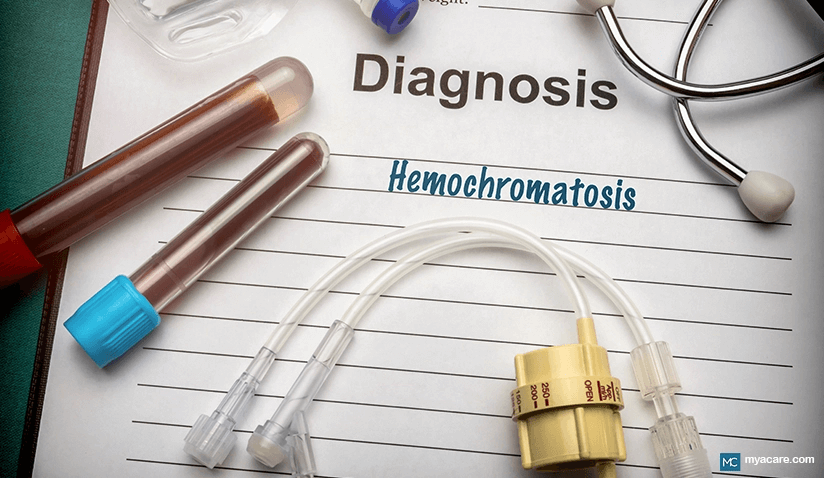What Is Hemochromatosis?

Hemochromatosis is a condition in which the body takes up too much iron that then is deposited in organs causing damage. Iron is an important part of hemoglobin, the protein that is found on red blood cells to which oxygen attaches. The concentration of iron in the blood needs to be within certain limits and it also must not be deposited at high levels in the organs.
People with hemochromatosis often suffer from liver problems and other complications like a heart attack or aneurysms as the iron deposits in organs cause damage. It may be difficult to diagnose hemochromatosis because some of the symptoms are nondescript and occur with other diseases. This includes both the hereditary forms of the illness and the form that can occur in infants due to maternal antibodies attacking the blood cells.
Causes of Hemochromatosis
Hemochromatosis is usually due to one of several gene mutations related to iron and the transport of iron in the body. These genetic mutations of concern are listed and described below.
- The hemochromatosis gene for type I hemochromatosis is the homeostatic iron regulator (also called HFE). If you have this mutation then your body does not properly sense how much iron is present leading to an overload. The disease is hereditary but this mutation does not cause a problem unless each of the parents is a hereditary hemochromatosis carrier.
- Transferrin receptor 2 (TRF2) gene mutations cause another type of hemochromatosis. The TFR2 protein made by this gene helps the iron be properly taken up by the cells so that there is not an excess in the bloodstream. The mutation results in a malformed protein that cannot function properly leading to excess iron.
- SLC40A1 gene mutation causes ferroportin disease. In this type of hemochromatosis, ferroportin protein is not formed properly. This protein helps absorb iron and moves iron out of the liver and spleen. The mutated gene fails to make a protein that properly transports the iron.
Neonatal hemochromatosis is when the condition occurs in babies at birth. It is caused by the mother’s own antibodies attacking the liver of the fetus. This causes liver damage resulting in the newborn having the condition at birth. It is a very rare condition though.
Hemochromatosis Symptoms
Symptoms of hemochromatosis include the following:
- Skin that has a bronze hue.
- Exhaustion
- Pain in the joints, including gout due to excess uric acid caused by hemochromatosis.
- Night sweats
- Thyroid problems: Mostly hypothyroidism
- Liver damage: Cirrhosis in which the liver becomes scarred is common, particularly in males who are ill.
- Liver cancer: This can occur due to hereditary hemochromatosis.
- Pancreas problems: Diabetes can occur as a result of pancreas damage.
- Heart failure: Iron can be overly deposited in the muscle of the heart leading to an irregular heartbeat and eventually, heart failure.
- Reproductive system problems: Infertility and erectile dysfunction can occur.
Neonatal hemochromatosis symptoms are:
- Skin that is yellow due to jaundice (common in babies born with hemochromatosis).
- Hypoglycemia: Low blood sugar.
- Problems with blood clotting.
Hemochromatosis Diagnosis
Diagnosis of hemochromatosis can be done in the following way:
- Blood tests: Technicians record levels of certain proteins besides recording the level of iron. Both ferritin and transferrin are noted. These are both proteins involved in iron uptake and transport. Hemochromatosis labs include looking at critical ratios, specifically the ratio of iron to transferrin. A high value here indicates the condition.
- Genetic tests: There are specific hemochromatosis tests that involve looking for genetic markers. Genetic mutations such as those we mentioned before, can be searched for through gene testing.
- Liver tests: Since the liver is often damaged by hemochromatosis, a liver biopsy can show the accumulation of iron typical of the condition. A microscopic examination of liver cells can be specially dyed to show the iron. The pathologist can then calculate how much iron there is.
Hemochromatosis Treatment
Treatment of hemochromatosis is by removing a certain amount of blood at a time. The proportion of iron to transferrin is then determined. This is done one or two times each week until the values have stabilized. About half a liter of blood is removed each time.
Another option for treatment is iron chelation therapy in which the medications such as deferiprone or deferoxamine are given that bind to iron; this may work instead of transfusion. This is sometimes done in people who have serious cardiac complications from the illness.
It is recommended that patients also follow a hemochromatosis diet. Note: Your diet may need modification if you have diabetes or other problems. Always check with your doctor before beginning a new diet.
The recommendations for patients with hemochromatosis are as follows:
- Do not eat food fortified with iron.
- Avoid red meats that are rich in iron, rather choose fish or eggs for animal protein.
- Fish should be eaten about four times a week.
- Choose lots of vegetables and fruits as part of a healthy diet.
- Include high-protein vegetables such as legumes.
- Eat whole grains, but first, make sure that no iron has been added.
- Reduce the intake of sugar.
- Reduce the intake of salt.
- Drink a lot of water rather than sugary soda.
- You can drink some fruit juice, tea, and coffee (coffee should be restricted if you have heart problems).
- Do not drink alcohol – alcohol increases the uptake of iron.
Additional medical treatment may be needed because of the damage caused by the extra iron. ultrasound screening may be needed for the liver to check for cancer in the future.
Treatment of Neonatal Hemochromatosis
Intravenous immunoglobulin is given and infants also undergo a blood transfusion. These treatments have proven successful. This removes the harmful antibodies from the blood of the baby. In severe cases where the liver is too badly damaged, an infant may need a liver transplant.
Conclusion
Hemochromatosis is most often a hereditary disease although there is a rare neonatal form of hemochromatosis that occurs. Quick diagnosis of this condition is crucial to reduce the chance of severe organ damage. Treatment involves a series of blood transfusions, and for neonates, IV immunoglobulin is also helpful in addition to transfusions.
To search for the best Gastroenterology healthcare providers in Germany, India, Malaysia, Spain, Thailand, Turkey, Ukraine, the UAE, the UK and The USA, please use the Mya Care Search engine.

Dr. Rae Osborn has a Ph.D. in Biology from the University of Texas at Arlington. She was a tenured Associate Professor of Biology at Northwestern State University, where she taught many courses to Pre-nursing and Pre-medical students. She has written extensively on medical conditions and healthy lifestyle topics, including nutrition. She is from South Africa but lived and taught in the United States for 18 years.
Sources
Featured Blogs



